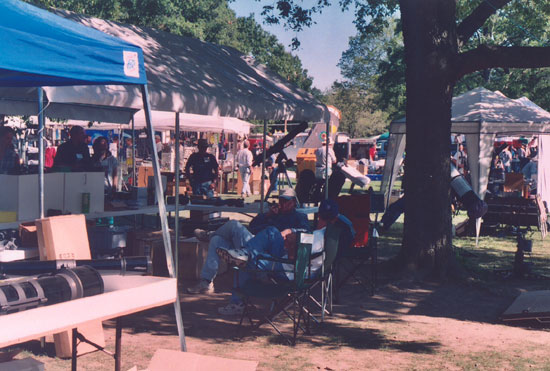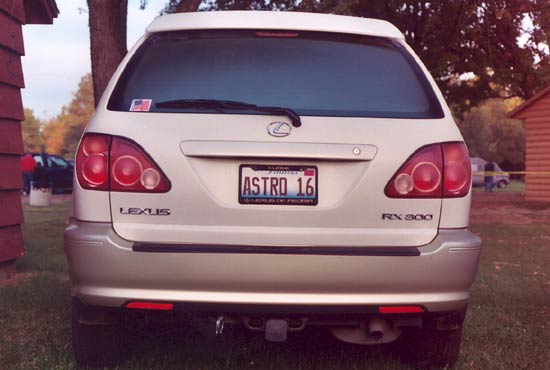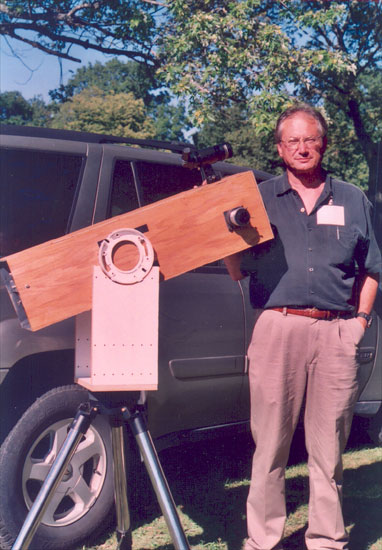


Sometimes, in the depths of winter, it’s good to be reminded that there is, indeed, a summer, and a time when Astronomy can be done easily and in comfort. In my opinion, the best time to be outdoors is late August. Astrofest takes place in early September, and it makes for an almost perfect mini-vacation.
Astrofest is a large gathering of amateur astronomers, organized by the Chicago Astronomical Society, and held at a Girl Scout Camp near Kankakee, Illinois at the end of summer. The latest one took place on Thursday, Friday, and Saturday, September 18, 19, and 20, 2003. Amateur astronomers get together south of Chicago for relatively dark skies and to compare notes on telescope making. Astrofest is not noted for its dark skies, as are the Texas Star Party and the Black Forest Star Party, nor for the steady air of the Winter Star Party in the Florida Keys. It is not the hard-core hardware event that is the Riverside get-together, but is rather a hybrid, where telescope makers join with observers for a more moderate experience.
This year, the Lowbrows were represented by Jack Brisbin and me. Since the event makes it a policy to admit 998 other people, there was plenty to see and do. Incidentally, if you decide to go next year, information about the event can be found on the Chicago Astronomical Society’s website (http://www.chicagoastro.org/), and I recommend registering early, because admission at the door is $100 per adult. (This is obviously some kind of Darwinian tax). Since both Jack and I had pressing work schedules, we traveled separately and agreed to meet up at the event sometime on Friday.
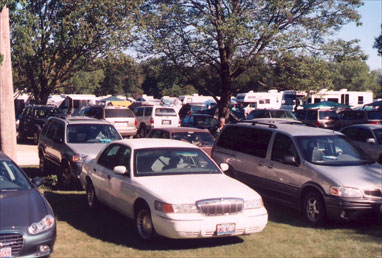
Driving there is a very straightforward, though boring, process; a boon for someone like myself who gets lost two blocks from home. I packed my toothbrush and red flashlight (telescopes are optional) and took I-94 to US-80 to I-57 to Kankakee. From there I followed the directions on the map and pulled into the camp just as it was getting dark. The organizers met me at the gate, verified that I prepaid my admission, and handed me an info package containing a list of the scheduled events, general instructions for getting around, and some vendor advertising. I turned out my car’s lights and proceeded cautiously to a parking space.
I like to park my car in the grassy parking lot near the gate at the west side of the observing field. The treed parking area is 50 yards from the RV’s, cars and tents which occupy the field, and is quieter and more private than camping on the field or in the cabins. This is important, since I sleep in my car (a habit I cultivated in college). When Doug Nelle and I first started going to Astrofest, we rented space in one of the unheated cabins which are scattered around the east side of the observing field. However, two consecutive years of sharing a very small space with a very loud snorer soon convinced us to seek other accommodations. Doug bought a camper, and I just slept in my car.
When I stepped out of my car into the dark, I was greeted by the sound of grasshoppers and the low murmur of astronomers at work under brilliantly lit starry skies. Since it was the end of a five hour drive, the first thing I did was to work my way across the field (it is set up with lanes like a giant parking lot, except the parking spaces have tents and telescopes in them) to the restrooms, while trying to note any extraordinary telescopes I passed on the way.
The restrooms are off by themselves behind the cabins, and are dark (remember the red flashlight?) out of consideration for the observers. They also have cold, and occasionally not so cold, running water for washing up. The camp is rustic, but not Stone Age. There’s a building for the men, and a separate one for the women.
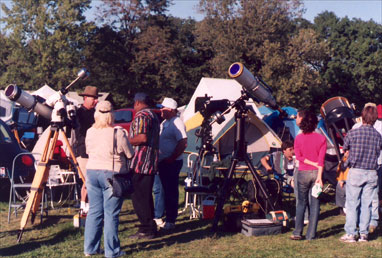
For the first part of the night, I walked the field, up one lane and down another. I was looking for groups of observers waiting in line for a view through some interesting telescope, and when I found one, I’d join in and listen to what they had to say. Usually, the people were talking about the view through the scope, and eventually the line would end at the eyepiece and I could compare what they said to what I saw.
It’s possible to learn an awful lot about telescopes, both individually and in general, by this technique. Telescopes vary tremendously, and a person can get a lifetime of experience in a place like this. Want to look through a Questar? There were five of them there, all in a group, and their owners were all happy to show off their instruments. AstroPhysics refractors? There are new ones from the vendor waiting to be sold, and older models, no longer made, in private hands. Living with them for a few years has given their owners a perspective on their strengths and weaknesses, and they are happy to share their experiences. Starmaster scopes, Coronado filters, Tinsley Cassegrains, Cave Astrolas; they’re all here and available for evaluation.
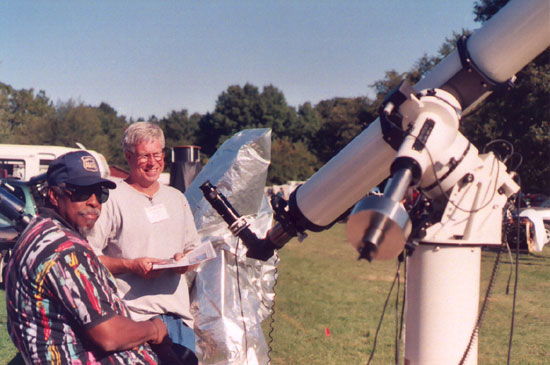
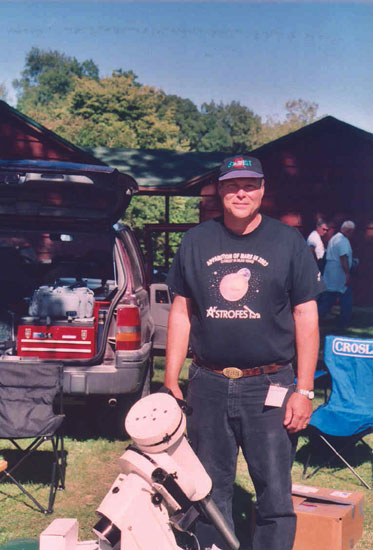
There are also amateur built scopes to look through. Amateurs have produced some of the most interesting and inventive designs at Astrofest. There are a few telescopes which look as if their builders did not have a talent for design, but most of the home built scopes incorporate clever and effective ways of getting starlight into the eye for extended periods of time. One of the most interesting things I learned by looking through a lot of scopes is the fact that the quality of both professional and amateur optics can not be predicted by its source. There are very good and very bad optics in both camps. AstroPhysics quality has been uniformly excellent, but it was equaled in an amateur’s trischiefspiegler, and approached by many others. Similarly, there are some surprisingly poor performers in the professional ranks.
There is, also, often a disconnect between an optical design on paper and one that is actually built. Sometimes this is due to workmanship, as was the case when I looked at the build of a Jose Sasian design with a toroidal corrector, and sometimes it is due to things that the optical design program doesn’t model or predict. The Houghton telescope looks very good on paper, but when it was capably built as a prototype by Roland Christian of AstroPhysics, it did not seem to perform well. “Too much glass” was the verdict. Sometimes, only the trying will tell, and at Astrofest, you can try before you buy.
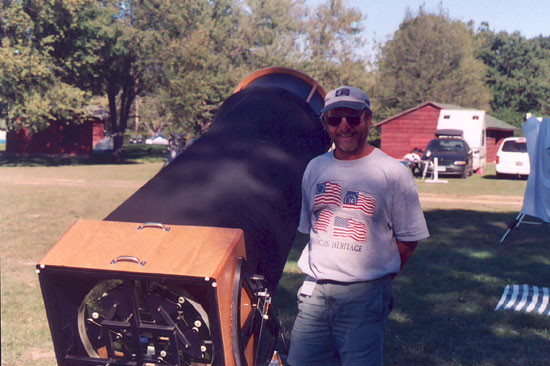
Mars was near opposition, and it got the most attention that night. The air was not particularly steady until quite late, but the sky was very clear. Dan Mitchell of Bloomington, IL, brought his 24” f/4.3 Starmaster with a Zambuto mirror for its first light, and I spent quite a bit of time admiring the design and workmanship which enabled him to have a transportable 24” telescope.
About the time the Pleiades rose over the trees, I decided to pack it in for the night. A clear sky can make for a very cold night, and when I got to my car, I discovered that I had forgotten to bring either a sleeping bag or blankets. I have heard that a man can freeze to death faster in a car than in the open, and while I haven’t personally tested the latter, I very nearly did the former. By the time the sun lit up the eastern sky, I think I had gotten about fifteen minutes of very unrestful sleep.
The only good thing about being unable to sleep is it got me to the showers first. A few years ago, Camp Shaw-Waw-Nas-See installed showers with hot water, and if you are one of the first five people to use them, there is actually hot water coming out of the tap. As we know, hot water, and not private property, is really the foundation of civilized society, and that day I was able to start off as a member of the human race. Groggy, but a member.
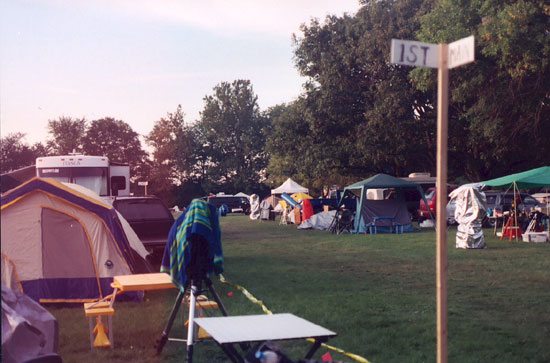
Breakfast at the trunk of my car followed (the milk for the cereal didn’t need special refrigeration), and as the sun rose, I could see the tents on the field for the first time. Every year Astrofest seems to grow in size and colors. There were banners flying from some of the tents, there were signs out in front of campers announcing the names of the occupants, there were even street signs at the intersections. People were preparing breakfasts or lining up in front of the mess hall where they could get a regular breakfast, if they had signed up for it.
I headed over to the east side of the field, where the tables and tents for the swap meet were being set up. I, of course, am a hardware junkie, and I didn’t want to miss out on any of the best stuff that was being dredged up from some guy’s basement on the stern recommendation of his wife.
There were tents full of surplus optics, old books, astro art, T-shirts and meteorites. There were bits and pieces of things that had once worked, and could again, but whose present owners had moved on to new and equally improbable projects. There were commercial vendors and lots of Russian optics at very (suspiciously?) low prices. I was almost immediately offered a deal on a 6” Russian Maksutov, a very nicely finished scope with a “flip” diagonal/finder, for $250. The seller, who, I suspect, imports these directly from a relative of his in Russia, said that there was just a little astigmatism in the image, but he was sure it was due to a misaligned something, and that a little effort on my part would make it perfect, and would I consider buying it for $200? I promised to think about it and moved on to the next booth.
Someone there was selling a 5” minor axis, 1/8 wave diagonal mirror for $275, and I briefly considered buying it for the club, so we could turn the 24” into an f/4 Newtonian/Cassegrain with a rotating secondary cage, but common sense seized me by the collar and moved me further down the row. You see how it goes? They’re not selling junk at these places. They’re selling dreams, and like a gambler, I’m addicted to the idea of the next big win. The next big find. My only defense against this dark side of my nature is to bring very little money with me. It’s not a perfect defense. In the past, I bought a 26” Cervit mirror blank here by going into town and arranging for a second mortgage on my home at a bank. I would have bought a second blank (the guy had two), but I have a very small house. Happily, though, that deal eventually turned out well, although it took three years to resell it as part of a project. This year, I was content to buy a circular polarizer for $10. Oh, the fun you can have with optics!
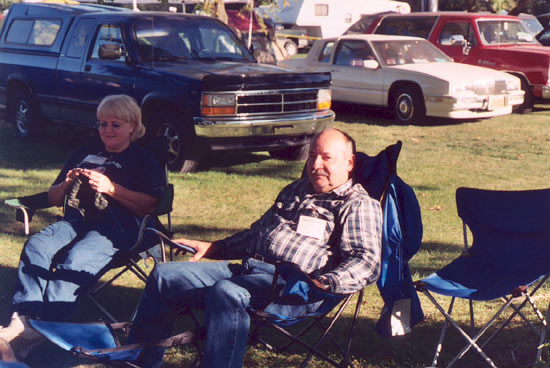
The optician Ed Jones was sitting behind a card table with some beautifully polished lenses on it. He was selling them as null lenses for testing parabolas. They were priced very low for what they were, but they were not selling well, probably because so few people make optics any more. He was also selling a copy of an optical design program called OSDP, but it was DOS based, and while it worked, most guys have moved on to Zemax. I spent some very enjoyable time talking to him about making optics. He works for a company in Ohio that makes production optics, and described the advantages of diamond laps for fining glass, and we talked about our current projects for a while.
Further down the way, I ran into Jack. He had his newest scope set up and was selling some items on a table next to it. He showed me some of the things he had bought, and I showed him the polarizer. His scope is a very interesting design. It has a coma corrector in it, made with off the shelf optics. The design appeared in one of the last issues of Telescope Making a few years ago, I think, and Jack bought the lenses and built the thing. He was having some trouble getting it to work, and we decided that the mirror was probably placed too far back in the tube to enable the coma corrector to operate at the best position. Coma correctors are designed to work at a certain distance from the focus, and this one couldn’t get there until Jack remounted his primary.
By this time, people were lining up in front of the mess hall for lunch, and Jack and I decided to go into Kankakee and find something to eat, since neither of us had signed up for meals. The Astrodog stand wasn’t in evidence this year, so a restaurant meal was it.
Kankakee is a very pleasant town, somehow reminiscent of my own home town in the 1950’s. It has a number of good places to eat, and Jack and I stopped at one where we had eaten in a previous year. The food was good, the company and conversation excellent, and we returned to the camp restored and ready to explore the field by the light of day. The scheduled talks after lunch weren’t of interest to either of us this year, so I grabbed my camera to get pictures of some noteworthy scopes I had seen the previous night and any interesting new ones.
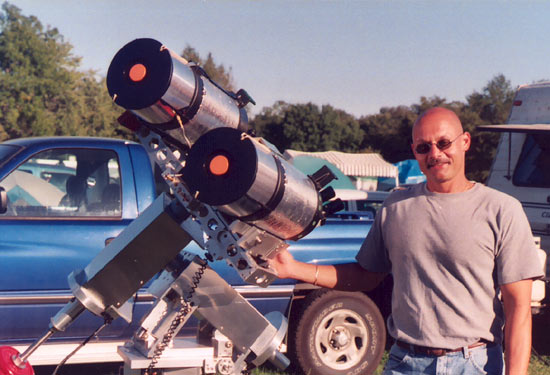
One of the first scopes to catch my eye was made by Mark Cabaj of the T.C.C.A. of Bloomington, Illinois. Its mount was entirely made of aluminum, and at first, I thought Mark must be a machinist, but he told me that he was actually a junior high school teacher, and had made the mount himself, using only a table saw and drill press. The mount was amazing, and Mark said that he had plans to make it even better next year.
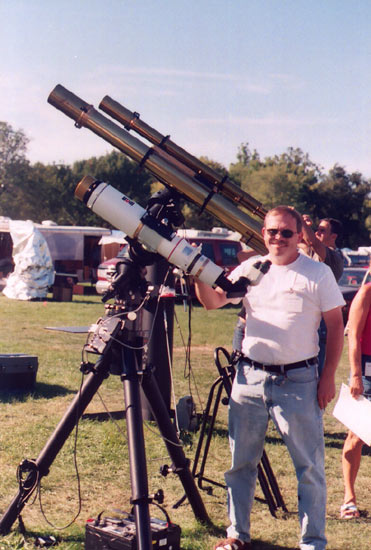
I crossed the field to get a picture of Dan Mitchell, and ran into a group of people looking at the noonday sun through some small refractors. When I looked through one of the scopes, its owner, Steve Sands of the St. Louis Astronomical Society, told me that the refractor was a TMB from Williams Optics. He said it was a 4” f/8 Fluorostar triplet with a 90 mm Coronado filter attached to it. The Coronado filter includes an etalon with a 0.6 nm band pass, and can be tilted to shift the pass wavelength in order to view dopplered material. Steve did this for me while I looked through it, and the view changed from the best resolved solar prominences I have ever seen, live or on film, to the second best view of solar granulation (I did some work for a solar astronomer while an undergraduate at the U of M) I have ever seen. The resolution was incredible. Even with the heat of the field boiling around us, the details on the sun appeared tack sharp. I had seen one of these filters at Astrofest the previous year, and at the time was surprised that someone would think that they could make money selling what appeared to me to be a very technical piece of space hardware. Obviously, I didn’t look through it at the time, or I would have realized how desirable these things are when coupled to a good telescope.
There were other good scopes on the field, but they had been there in previous years, and their owners had not changed them in any obvious way. Jack and I headed back across the field to look at the photo entries in the Astrophoto contest, and as we passed the table where the Maksutov had been for sale that morning, I saw that it was gone. The seller rejoicingly told me that he had sold it for $300, and that I was really stupid for passing it up. In a thick Russian accent, he said I would regret it forever, and I must be an idiot for not seeing such value. But actually, I was so delighted with his naked display of a kind of pure capitalism that is found only in immigrants from formerly communist countries, that I told him I was genuinely glad he got such a good price for it. I think that made two of us.
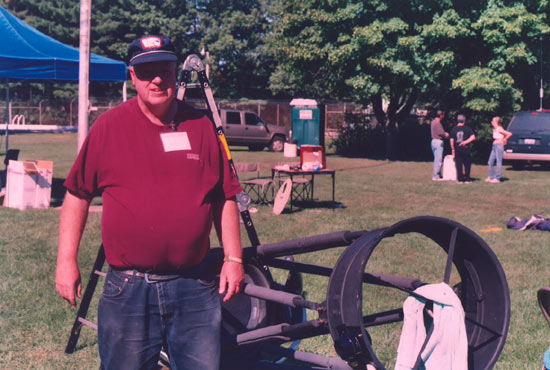
On the north side of the mess hall is a smaller field, where people can set up if they want to pay for electricity. There, Dan Joyce of the Chicago Astronomical Society had set up his 18” JMI scope. He used to work in the Adler Planetarium Optical Shop, teaching people how to make a telescope. He has his own shop now, and is doing freelance work. He is a tremendously talented optician. He figured Don Parker’s 16” mirror, the one that is used to take those breathtakingly sharp pictures of planets from Florida, and he figured the mirror in his JMI. I looked through it a year or two ago, on a night when we had really good seeing. The mirror is very, very good. I told him I was figuring a large, fast mirror at the time, and he generously described some of his methods for figuring mirrors. Because of his high standards, he won’t work on thin mirrors, but if you need an excellent mirror at a very reasonable price, he’s the one to call.
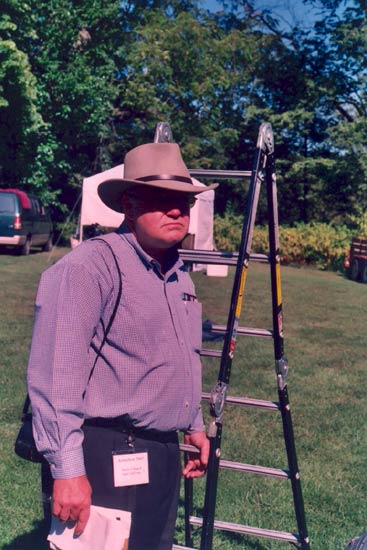
Nearby was Terry Clinard, who owns OptiCraft Engineering. This was his first time at Astrofest, and I wanted to meet him. Roger Tanner, of the Lowbrows, had bought his first big mount from him many years ago. Roger told me that the only machine tool he saw at OptiCraft was a drill press, and the pillow block and aluminum plate mount had some problems supporting his 6”, despite having shafts on the order of 2” in diameter. When I looked at it, I told Roger that I had to give OptiCraft credit. A man has to be pretty bold to locate a precision gear by three flat head screws. Nevertheless, when Roger asked me to rebuild his mount to carry his 16”, I was surprised to find that we were able to reuse the original mount’s big aluminum worm gear and those three flat head screws. The rest of it, though, was sold for five cents a pound.
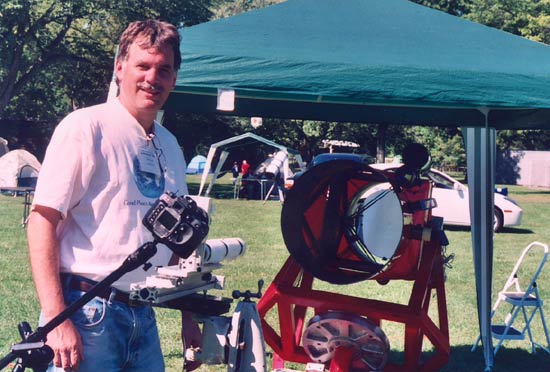
Next to Dan was a large red telescope with a 20” mirror, and a guy named Dave Otto was trying to get an interferogram of the mirror. This was an incredibly optimistic undertaking under the circumstances, but Dave is a nice guy, and obviously talented, because I saw fringes through the interferometer. Last year, he and I disagreed about the optical design of his interferometer, but it turned out that his design, while not pure, should produce a fairly accurate picture of his particular mirror’s surface. Dave and some friends are grinding a 40” fused silica mirror (the same blank that Norm Oberle, Jim Thomas, and I had back in 1970 for the LEAP project) for amateur radial velocity studies. There is a web site at http://spectrashift.com, if you want to see a truly interesting and ambitious undertaking.
Dinner time came and went. I headed over to see Detlef Schmidt, the owner of Starlight Instruments, Inc., to see if he was giving away his excellent “Feather Touch” focusers at his vendor’s table. He wasn’t, but I can wait a while. His focusers are machinist’s dream, and they work well, too. I promised to buy one, when I’m next shopping for a focuser. He’s a perfectionist and the design will only improve with time.
After dinner, the door prizes were drawn in the mess hall and announced over the loudspeakers. You had to be present to win, but only a fraction of the people could fit in the building, so most of us gathered around outside to hear if our names were called. There were a lot of prizes, ranging from the glorious to the mundane. It took about ninety minutes for Jack and me to discover that neither of us were winners (what was that?), but we were entertained by the mad rush of the winners to get into the building to claim their prizes before the crowd counted down to zero and drew another lot. If the prize was a good one, the crowd could count pretty fast.
By the time all of the prizes were given away, it was dark enough to tell that it wasn’t going to be a great observing night. Jack and I hung around for a while to look through the scopes which were still being used, but after a couple of hours, about half the people had packed up, and Jack decided to join them and head back to Michigan. I wanted to get some sleep before starting back, so Jack lent me a blanket from his truck and saved me from a) Freezing to Death or b) Driving into a Bridge Abutment While Asleep at the Wheel. Thanks, Jack. See you next year at Astrofest.
